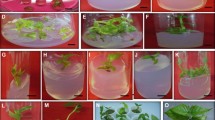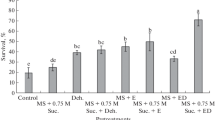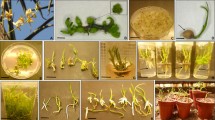Abstract
Asparagus racemosus is a commercially important medicinal plant, traditionally used for combating gynecological problems in India. The majority of plants used by the pharmaceutical industry come from wild sources, endangering the natural population of the species. The plants are being overharvested, so this species faces a real danger of becoming vulnerable in its natural habitat. Ex situ conservation using in vitro tools is a possible solution to this problem. Ex situ conservation of plants involving in vitro tools has been initiated through axillary branching using nodal explants. Studies on in vitro storage under slow-growth conditions were carried out to develop an efficient protocol for conservation of A. racemosus germplasm. In vitro shoot cultures generally require a 4-wk subculture onto fresh medium when grown at 25 ± 2°C under a 16-h photoperiod. In this research, the use of mannitol or sorbitol as an osmoticum and reduction of sucrose to 1.5% (w/v) in half-strength MS medium led to maintenance of the cultures for 6 mo at 25 ± 2°C with no subculture. Surviving shoots from the slow-growth cultures could be regenerated with 100% efficiency, indicating that the subculture interval was successfully extended by this method. Temperature and medium modification both had significant effects on the growth of stored shoots, and the two factors showed significant interaction. In experiments designed to test encapsulation as a storage method, micropropagated shoot clusters encapsulated in calcium alginate beads were successfully stored up to 75 d at 25 ± 2°C under a 16-h photoperiod. Stored shoots from both storage methods were subsequently recovered and multiplied on MS medium with 3% sucrose and 1.11 μM benzylaminopurine at 25 ± 2°C. Well-developed shoots were rooted and acclimatized successfully.


Similar content being viewed by others
References
Abebe T, Guenzi AC, Martin B, Cushman JC (2003) Tolerance of mannitol-accumulating transgenic wheat to water stress and salinity. Plant Physiol 131:1748–1755
Akdemir H, Kaya E, Ozden Y (2010) In vitro proliferation and minimum growth storage of Fraser photinia: influences of different medium, sugar combinations and culture vessels. Sci Hortic 126:268–275
Bapat VA, Rao PS (1990) In vivo growth of encapsulated axillary buds of mulberry (Morus indica L.). Plant Cell Tissue Organ Cult 20:67–70
Bekheet SA (2000) In vitro preservation of Asparagus officinalis. Biol Plant 43:179–183
Bopana N, Saxena S (2008) In vitro propagation of a high value medicinal plant: Asparagus racemosus Willd. In Vitro Cell Dev Biol Plant 44:525–532
Chawla HS (2002) Introduction to plant biotechnology. Science Publishers Inc., Enfield
Conner AJ, Falloon PG (1993) Osmotic versus nutritional effects when rooting in vitro asparagus minicrowns on high sucrose media. Plant Sci 89:101–106
Cordeiro SZ, Simas NK, Henriques AB, Sato A (2014) In vitro conservation of Mandevilla moricandiana (Apocynaceae): short-term storage and encapsulation–dehydration of nodal segments. In Vitro Cell Dev Biol Plant 50:326–336
Dahlgren RMT, Clifford HT, Yeo PF (1985) The families of the monocotyledons. Springer, Heidelberg
Divakaran M, Nirmal Babu K, Peter KV (2006) Conservation of Vanilla species, in vitro. Sci Hortic 110:175–180
Dodds JH, Roberts LW (1995) Experiments in plant tissue culture. Cambridge University Press, New York
Engelmann F (1991) In vitro conservation of tropical plant germplasm—a review. Euphytica 57:227–243
Engelmann F (1997) In vitro conservation methods. In: Callow JA, Ford-Lloyd BV, Newbury HJ (eds) Biotechnology and plant genetic resources. CAB International, Wallingford, pp 119–161
Fletcher PJ (1994) In vitro long‐term storage of Asparagus. N Z J Crop Hortic 22:351–359
Janeiro LV, Vieitez AM, Ballester A (1995) Cold storage of in vitro cultures of wild cherry, chestnut and oak. Ann Sci 52:287–293
Kar DK, Sen S (1985) Micropropagation of Asparagus racemosus. Plant Cell Tissue Organ Cult 5:89–95
Kovalchuk I, Lyudvikova Y, Volgina M, Reed BM (2009) Medium, container and genotype all influence in vitro cold storage of apple germplasm. Plant Cell Tissue Organ Cult 96:127–136
Marino G, Negri P, Cellini A, Masia A (2010) Effect of carbohydrates on in vitro low-temperature storage of shoot cultures of apricot. Sci Hortic 126:434–440
Micheli M, Mencuccini M, Standardi A (1998) Encapsulation of in vitro proliferated buds of olive. Adv Hortic Sci 12:163–168
Micheli M, Hafiz IA, Standardi A (2007) Encapsulation of in vitro-derived explants of olive (Olea europaea L. cv. Moraiolo) II. Effects of storage on capsule and derived shoots performance. Sci Hortic 113:286–292
Mitra SK, Gopumadhavan S, Venkataranganna MV, Sarma DNK, Anturlikar SD (1999) Uterine tonic activity of U-3107, a herbal preparation, in rats. Indian J Pharm 31:200–203
Murashige T, Skoog F (1962) A revised medium for rapid growth and bioassays with tobacco tissue cultures. Physiol Plant 15:473–497
National Medicinal Plants Board (2002) http://www.nmpb.nic.in. Accessed Jun 2014
Negash A, Krens F, Schaart J, Visser B (2001) In vitro conservation of enset under slow-growth conditions. Plant Cell Tissue Organ Cult 66:107–111
Obermeyer AA (1983) Protasparagus Oberm. nom. nov.: new combinations. S Afr J Bot 2:243–244
Pandey A, Sinha A (2013) Effect of mannitol, sorbitol and sucrose on growth inhibition and in vitro conservation of germplasm of Asparagus racemosus—an important medicinal plant. Med Plants Int J Phytomed Relat Industries 5:71–74
Pant KK, Joshi SD (2009) In vitro multiplication of wild Nepalese Asparagus racemosus through shoots and shoot induced callus cultures. Bot Res Int 2:88–93
Pattnaik SK, Chand PK (2000) Morphogenic response of the alginate encapsulated axillary buds from in vitro shoot cultures of six mulberries. Plant Cell Tissue Organ Cult 60:177–185
Pattnaik SK, Sahoo Y, Chand PK (1995) Efficient plant retrieval from alginate-encapsulated vegetative buds of mature mulberry trees. Sci Hortic 61:227–239
Pise M, Rudra J, Bundale S, Begde D, Nashikkar N, Upadhyay A (2012) Asparagus racemosus cell cultures: a source for enhanced production of shatavarins and sarsapogenin. In Vitro Cell Dev Biol Plant 48:85–91
Sarkar D, Naik PS (1998) Factors affecting minimal growth conservation of potato microplants in vitro. Euphytica 102:275–280
Shen B, Jensen RG, Bohnert HJ (1997) Mannitol protects against oxidation by hydroxyl radicals. Plant Physiol 115:527–532
Singh AK, Varshney R, Sharma M, Agarwal SS, Bansal KC (2006) Regeneration of plants from alginate-encapsulated shoot tips of Withania somnifera (L.) Dunal, a medicinally important plant species. J Plant Physiol 163:220–223
Standardi A, Piccioni E (1998) Recent perspectives on the synthetic seed technology using non-embryogenic in vitro-derived explants. Int J Plant Sci 159:968–978
Sujatha G, Ranjitha Kumari BD (2008) Micropropagation, encapsulation and growth of Artemisia vulgaris node explants for germplasm preservation. S Afr J Bot 74:93–100
Tyagi RK, Goswami R, Sanayaima R, Singh R, Tandon R, Agrawal A (2009) Micropropagation and slow growth conservation of cardamom (Elettaria cardamomum Maton). In Vitro Cell Dev Biol Plant 45:721–729
Warrier PK, Nambiar VPK, Ganapathy PM (2001) Some important medicinal plants of the western ghats, India: a profile. International Development Research Centre, Artstock, p 15
Withers LA (1980) Tissue culture storage for genetic conservation. IBPGR technical report. International Board for Plant Genetic Resources, FAO/ United Nations, Rome
Acknowledgment
We acknowledge the School of Studies in Biotechnology, Pt. Ravishankar Shukla University, Raipur, India, for providing the necessary lab facilities.
Author information
Authors and Affiliations
Corresponding author
Additional information
Editor: Barbara Reed
Rights and permissions
About this article
Cite this article
Thakur, S., Tiwari, K.L. & Jadhav, S.K. In vitro approaches for conservation of Asparagus racemosus Willd.. In Vitro Cell.Dev.Biol.-Plant 51, 619–625 (2015). https://doi.org/10.1007/s11627-015-9706-9
Received:
Accepted:
Published:
Issue Date:
DOI: https://doi.org/10.1007/s11627-015-9706-9




